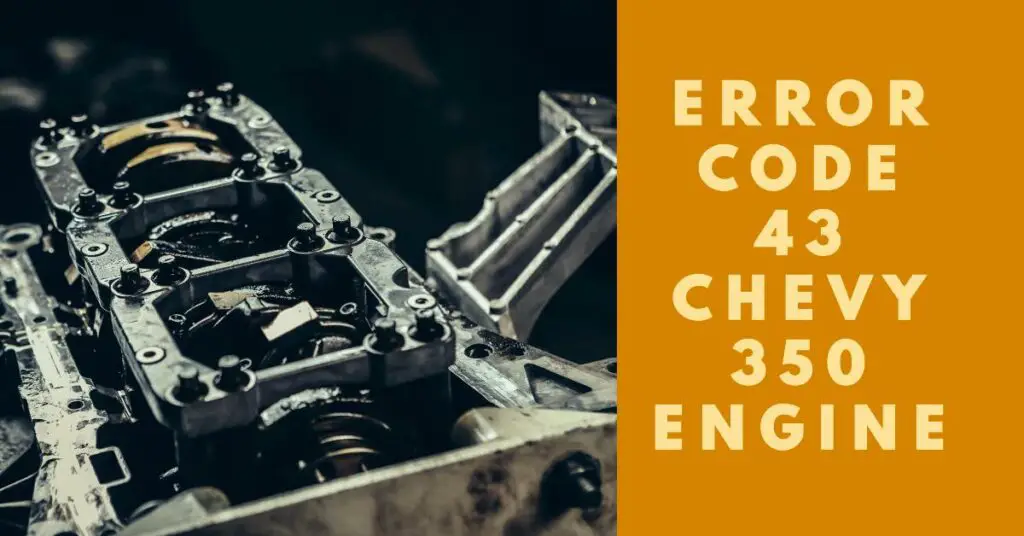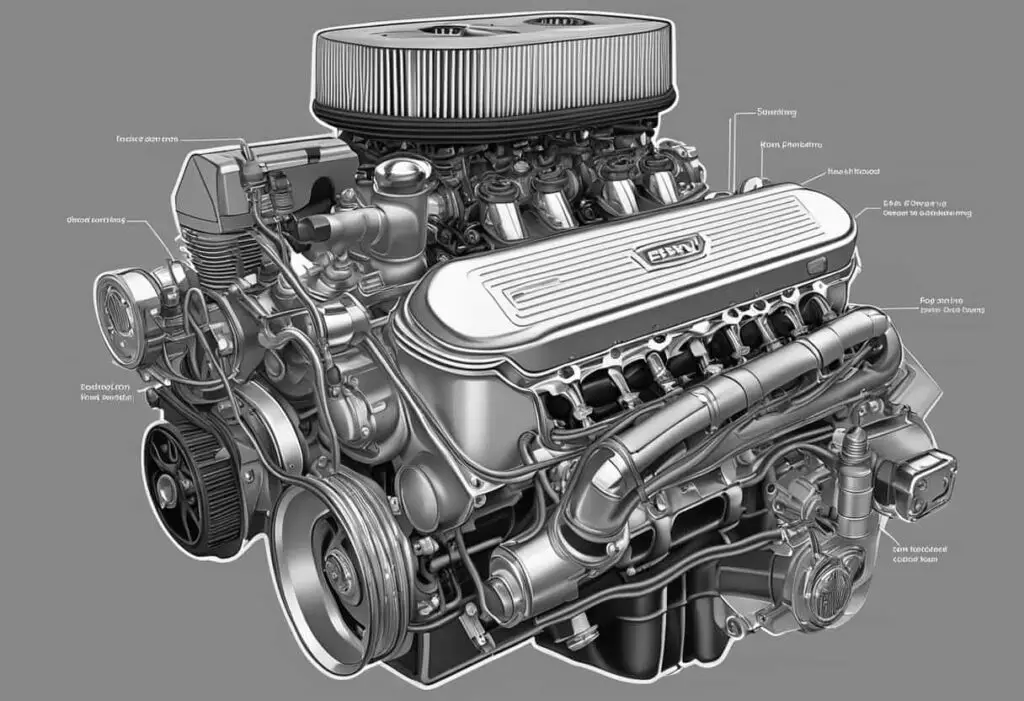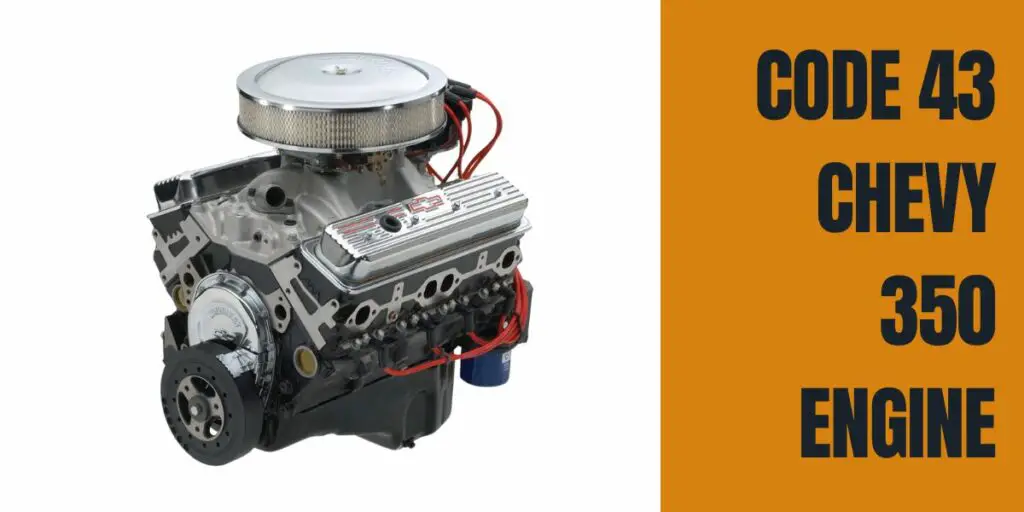I’m cruising down the highway in my beloved Chevrolet, feeling like I own the road.
Suddenly, out of nowhere, my engine starts acting up.
Panic sets in as I struggle to figure out what’s wrong.
That’s when I see it glaring back at me from the dashboard – Code 43.
If you’ve ever been in this situation, you know the sinking feeling it brings.
In this article, I will explain Code 43 Chevy 350 engine error and how to fix it.
What is the Code 43 Chevy 350?

Code 43 on a Chevy 350 engine indicates an Electronic Spark Control (ESC) circuit malfunction. The ESC system senses spark knock (pinging) and retards the ignition timing to eliminate it, using signals from the knock sensor to the ESC module and then to the ECM.
Learn how to adjust Chevy 350 timing marks yourself with our step-by-step guide.
How to Troubleshoot and Fix Code 43 Chevy 350 Engine

Follow these steps to troubleshoot and fix Code 43 Chevy 350 Engine:
1. Understand Code 43
- Code 43 is triggered by the Electronic Control Module (ECM) when it detects a problem with the knock sensor or the ESC circuit. It can result in reduced engine performance and increased fuel consumption.
2. Inspect the Knock Sensor
- Location: The knock sensor is usually mounted on the engine block or intake manifold.
- Check for Damage: Look for any physical damage to the sensor or its wiring.
- Test the Sensor: Use a multimeter to check the sensor’s resistance. Compare your findings with the manufacturer’s specifications.
3. Examine the ESC Module
- Location: The ESC module’s location can vary, but it’s often found near the distributor.
- Visual Inspection: Check for signs of corrosion or damaged wires.
- Electrical Testing: If equipped, verify the module’s power supply and ground connections using a multimeter.
4. Check Wiring and Connectors
- Inspect all related wiring harnesses and connectors for signs of wear, corrosion, or damage. Ensure all connections are tight and clean.
5. Test the Ignition Timing
- Incorrect ignition timing can trigger Code 43. Use a timing light to verify the timing is set according to the manufacturer’s specifications.
- Adjust the timing if necessary, following the procedure outlined in the service manual.
6. Replace Faulty Components
- If any defects are found during the inspections (knock sensor, ESC module, wiring), replace the faulty parts with new ones. It’s crucial to use quality replacement parts that meet OEM specifications.
7. Clear the Code and Test Drive
- After repairs, clear the diagnostic trouble codes using an OBD-II scanner.
- Take the vehicle for a test drive to ensure the issue is resolved. Pay attention to the engine’s performance and watch for the check engine light or the recurrence of Code 43 Chevy 350.
For tips on how to fix white smoke coming from your Chevy 350, check out my article on Chevy 350 White Smoke from Exhaust.
Role of the Electronic Spark Control (ESC)
The Electronic Spark Control (ESC) in your Chevy 350 is vital in optimizing your vehicle’s ignition timing. Its primary function is to detect and prevent engine knock, a common condition where fuel combusts prematurely in the engine’s cylinders, which can lead to damage.
ESC works with the Knock Sensor, which is mounted on your engine block. When this sensor picks up vibrations indicative of a knock, it sends signals to the ESC module. In response, the ESC system momentarily retards the ignition timing. This delay helps eliminate knock by allowing combustion to occur at the optimal moment, which is crucial for your engine’s performance and longevity.
Here’s how the ESC system manages this:
- Detection: The knock sensor detects the vibration frequencies characteristic of engine knock.
- Signal Processing: The ESC module processes these signals and determines if they meet the threshold for engine knock.
- Response: If a knock is present, the ESC sends a signal to the Engine Control Module (ECM) to retard the ignition timing.
Keep in mind:
- No Knock Detected: If no knock is detected during a test, a Code 43 may be set.
- Two Consecutive Tests: Most General Motors manuals state two consecutive test failures will result in a Code 43.
Check out my previous guide on fixing error code 59 on Chevy Spark where I discuss these issues in more detail.
Code 43 Chevy 350 Comparison Table
This table compares Code 43 Chevy 350 issue, detailing its nature, diagnosis, and resolution strategies:
| Aspect | Details |
|---|---|
| Error Code | Code 43 – ESC Circuit Malfunction |
| Symptoms | – Engine knocking or pinging at acceleration or under load – Reduced engine performance – Increased fuel consumption |
| Diagnostics | – Inspect the knock sensor and its connections for damage or wear – Check the ESC module for faults or wiring issues – Verify the ignition timing is correct and adjust as necessary |
| Causes | – Faulty knock sensor – Damaged or corroded wiring – Malfunctioning ESC module – Incorrect ignition timing |
| Fixes | – Replace the knock sensor if faulty – Repair or replace damaged wiring – Replace the ESC module if needed – Adjust the ignition timing to manufacturer specifications |
Refer to this wiring diagram of Chevy 350 engine Spark Plug, if you are facing issues with it.
Symptoms of Code 43 Failure
These are symptoms of the Code 43 Chevy 350 failure:
- Engine Knocking: The most common symptom is engine knocking or pinging when the knock sensor detects improper combustion.
- Reduced Engine Power: The engine might feel less responsive as the Electronic Control Module (ECM) attempts to correct the issue by retarding the timing.
- Poor Fuel Economy: If the timing is consistently retarded to prevent knocking, you may also notice a decrease in fuel efficiency.
- Erratic Engine Performance: Issues with the ESC system can lead to uneven engine performance, sometimes manifesting as stumbling or hesitation during acceleration.
- Illumination of Check Engine Light: A persistent Check Engine Light often accompanies a Code 43, signaling that the ESC circuit requires attention.
- Rough Idle: Especially when the vehicle is in gear, a rough idle can signal that the ESC is not properly regulating the engine’s timing.
Diagnosing and Troubleshooting Code 43 Chevy 350
Follow these steps to diagnose and troubleshoot Code 43 Chevy 350:
1. Performing a Compression Test
Start with a compression test to ensure the motor’s mechanical integrity. Even compression across all cylinders indicates that internal engine condition is sound and helps rule out mechanical noise as a culprit. If compression varies significantly between cylinders, this can impact the idle and overall engine performance, potentially triggering Code 43.
2. Inspecting the ESC Module
Next, inspect the ESC module. It should have proper ground and power, and the wiring harness must be free from damage and corrosion. The ESC module’s job is to receive signals from the knock sensor and, if it detects a spark knock, send signals to the ECM to adjust the timing accordingly. Check with a multimeter that the ESC module receives the correct amount of voltage—typically around 5 volts.
3. Checking the Knock Sensor
Finally, examine the knock sensor itself. This sensor’s role is to detect unusual vibrations or ‘knocking’ caused by improper combustion, which can also affect engine timing. A fault here may cause inappropriate signals to the ECM. Use a meter to check the knock sensor’s resistance against manufacturer specifications. It’s also wise to ensure the sensor and its circuit are free from wiring or EGR system faults, as this can cause incorrect voltage signals to the PCM.
Electrical System and Sensor Integrity
When troubleshooting Code 43 on a Chevy 350, it’s essential to ensure the integrity of the electrical system and sensors. This involves thoroughly assessing the electrical components, such as the wiring harness and connectors, and confirming the ground circuit’s quality.
Assessing Wiring and Connectors
Inspect the main wiring harness and plug wires for signs of wear, damage, or corrosion. It’s important to confirm that all connections are secure and that there isn’t any high-voltage leakage. A continuity test on the wiring can help you identify hidden issues, such as frayed wires or internal breaks that could disrupt the signal to the ignition control system.
- Visual Check: Look for signs of damage to the wiring insulation or connectors.
- Continuity Test: Use a multimeter to ensure each wire in the harness conducts electricity properly.
Evaluating the Ground Circuit
A solid ground connection is vital for the electronic spark control module to function correctly. Verify that the ground points are not compromised by rust or paint that can impede electrical flow.
- Voltage Check: A multimeter can measure potential differences and ensure that the ground circuit is not carrying an unforeseen volt load.
- Physical Inspection: Check that ground wires are attached securely to the engine block, away from areas like the heater hose, which could potentially cause damage due to heat.
By closely monitoring these elements and conducting precise assessments, you can rule out electrical system and sensor issues as the cause of Code 43 in your Chevy 350.
Advanced Troubleshooting Techniques
Follow these steps for Code 43 Chevy 350 advanced troubleshooting:
Analyzing the Ignition System
Your ignition system is critical for proper engine function and resolving a Code 43 error. Begin by checking the spark control module for any signs of damage or irregularities. Confirm that your base timing is set accurately, as incorrect timing can lead to performance issues. Utilize a timing light to ensure the ignition timing is within the manufacturer’s specification.
Next, examine the power connections to the ignition module and ensure they are secure and corrosion-free. Inconsistent power can cause erratic operation of the ignition system. Also, inspect the prom (Programmable Read-Only Memory) in the ECM, which contains calibration information critical for ignition control.
Refer to this Chevy Ignition Switch Wiring Diagram while analyzing the Ignition System.
Interpreting ECM and PCM Signals
Analyzing the ECM (Engine Control Module) and PCM (Powertrain Control Module) signals is a nuanced process that can provide insights into your Chevy 350’s malfunctions. Use a quality scanner to read the codes and ECM data stream for thorough diagnostics. Pay attention to any anomalies in the readings that could indicate a fault in the spark control circuitry or related shifts in parameters that may require recalibration.
When parsing the signals, observe the PCM behavior during different operating conditions. Anomalies in PCM operation can disrupt engine timing and power delivery. If your diagnostics indicate that the PCM is malfunctioning, consider whether reprogramming or replacement is necessary to resolve the Code 43 error.
FAQs on Code 43 Chevy 350
These are the most frequently asked questions about Code 43 Chevy 350:
What steps can be taken to resolve a code 43 on a Chevy 350?
Inspect the knock sensor and the ESC module for proper operation to resolve a code 43 indicating an Electronic Spark Control (ESC) fault. Ensure all wiring and connections are secure. You may also need to check the timing settings, as the system retards timing to prevent engine knock.
How can a code 43 be reset on a vehicle with a Chevy 350 engine?
To reset code 43 on your vehicle, disconnect the battery for a few minutes after fixing the underlying issue to clear the code from memory. Then, reconnect the battery and start the engine to see if the code reappears.
In the context of a Silverado 1500 with a Chevy 350, what does code 43 indicate?
For a Silverado 1500 with a Chevy 350, code 43 suggests a problem with the Electronic Spark Control system, which adjusts the engine’s timing to avoid knocking or pinging. Addressing this issue may involve testing the knock sensor or checking the EGR valve for proper function.
After changing the knock sensor, why might a code 43 still appear?
If code 43 persists after changing the knock sensor, this could indicate wiring issues, a faulty ESC module, or incorrect installation. Check for proper sensor connection and compatibility and inspect any related circuits or components for damage.
What does a code 43 mean on a 1993 Chevy truck with a 350 engine?
On a 1993 Chevy truck with a 350 engine, a code 43 typically means an ESC circuit malfunction. This could arise from various issues, from a bad knock sensor signal to problems with the ESC module.
What are common troubleshooting methods for code 43 on a 1995 Chevy K1500?
Common troubleshooting methods for code 43 on a 1995 Chevy K1500 include checking the knock sensor and ESC module and verifying the timing advance mechanism. Ensuring no vacuum leaks and the EGR system properly are also crucial steps.
Conclusion
Knowing about Code 43 Chevy 350 can help when your ride starts acting up. By understanding this error and how to deal with it, you’ll be better prepared for any problems that come your way. So, if you ever see Code 43 pop up, don’t worry. With some know-how, you’ll have your Chevy 350 back on the road in no time. Happy driving, and remember to stay informed about Code 43.
